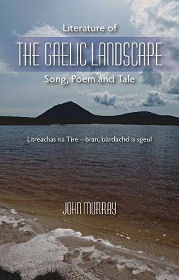 |
Unless they actively go out and seek it, the modern visitor to Scotland, certainly mainland Scotland, probably only encounters the Gaelic language in the form of alternative place names on signs on railway platforms; on greeting signs on roads leading into settlements; and as an alternative and additional set of names on direction signs on roads, sometimes at the expense of clarity and readability. Meanwhile the best that can be said from the 2011 Census about use of the language is that the rate of decline in the number of Gaelic speakers had reduced.
Yet considerable resource is being deployed to try to ensure that Gaelic not only survives, but thrives. To an outsider this can seem like an act of faith. It has been said that Scotland without Gaelic would be like Scotland without heather moorland: no-one would starve as a result, but as a nation we'd all be immeasurably poorer. Again, to an outsider this raises an obvious question: why?
"Literature of the Gaelic Landscape: Song, Poem and Tale" by John Murray shows very clearly why Gaelic is so important to Scotland as a nation as a whole, including to the 98.9% of the Scottish population (in 2011) who couldn't speak it. Scotland is a land which has been defined by its history in a way that is obvious wherever you look. Much of that history was experienced, especially in the north and west of the country, by people whose first, and often only, language was Gaelic. Gaelic language and culture underpins virtually everything we see around us in large parts of Scotland.
John Murray has becoming a leading light in drawing attention to the use of Gaelic in the landscape of Scotland. In 2014 we reviewed his "Reading the Gaelic Landscape" and concluded that it was "a remarkable book, and one that should be owned and consulted by everyone who had ever looked at a map of the Highlands and Islands of Scotland and wondered what lies beneath the surface of the fascinating, but, to English speakers, incomprehensible and usually unpronounceable, Gaelic names." His latest book is equally remarkable, and equally enlightening. Within it he goes beyond the scope of the earlier work to draw out associations with notable authors and poets who have written in Gaelic (and, in once case, English) and whose own deep love and understanding of the places where they lived and worked can be brought alive by following in their footsteps, as reflected in their writings.
The book begins with chapters on place names, mapping and toponomy. There are also chapters on the landscapes of the mythical hunter-warrior Finn MacCoul, while large sections look at the the landscapes associated with the work of three authors or poets: the Breadalbane and Argyll of Duncan Ban Macintyre; the Skye and Raasay of Sorley MacLean; and the Caithness and Sutherland of Neil M. Gunn. Each section draws together extracts from original texts alongside photographs, maps, and tables analysing place name origins in each author's works. The end result is a book of truly lasting value, and an important book that shows why the Gaelic language matters to all of us.
InformationPaperback: 256 pagesWhittles Publishing www.whittlespublishing.com 23 August 2017 Language: English ISBN-10: 1849953635 ISBN-13: 978-1849953634 Size: 26.1 x 1.8 x 24 cm Buy from Amazon (paid link) Visit Bookshop Main Page |
